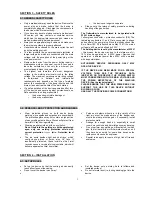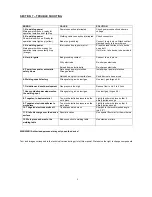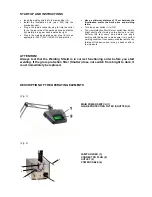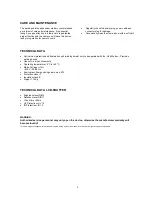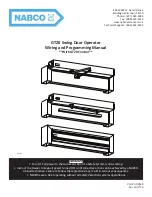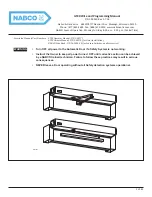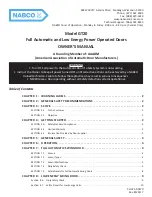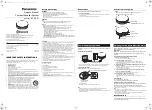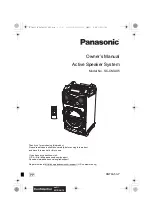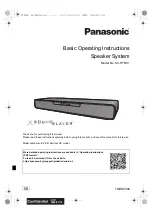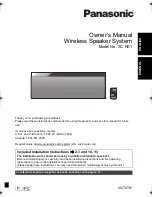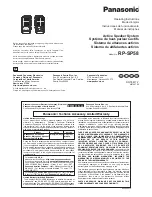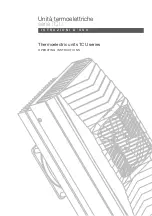
3
SECTION 3 – SAFETY RULES
3-1.GENERAL SAFETY RULES
•
Only a professional may open the device. Remove the
power plug and make certain that the device is
completely unplugged. . Discharge the components in
the device, which store electricity.
•
If you have any doubts, please contact a professional.
Of course, you may contact our customer service,
which has the appropriate resources and means, as
well as professionally trained personnel.
•
Always use appropriate length cables and make sure
the work piece clamp is properly attached.
•
Hazards could be caused by the main current as well
as by the welding current.
•
The law prohibits the non-professional electrician to
tamper with parts, which are connected with the main
voltage, with the exception of the power plug or the
main power switch.
•
Remove the device from the power during repair or
maintenance work on the power source. If you need to
leave the workstation, even only for a moment, you
must noticeably block the power plug.
•
The highest and therefore the most dangerous
voltage in the welding electrical circuit is the idling
voltage. The maximum permission able idling voltage
is determined in national and international
requirements and depends on the type of welding
power, the construction of the power source and the
more or less electrical hazard of the work station.
•
If a safe operation of the device seems doubtful, turn
off the device and secure against unintentional use.
Safe operation is no longer possible if
o
the device shows visible damage or,
o
the device malfunctions
o
the device no longer can operate
•
Please note the relevant safety precautions during
handling of the gas bottles.
The Optiwelder is manufactured to be operated with
230V~ main voltage
Yellow-green conductor = protection conductor (PE). The
remaining conductors L1 and N are connected to phase
and neutral of the power plug. Since the introduction of the
Euro Norm IEC 38 (effective since May 1987) the mains
voltage in all Europe is defined by 230V.
The welding device is set by the manufacturer at 230V!
– this means, the device may, due to the tolerance of +/-
15%, also be operated on a 220V power. Devices that
operate on a different power than 230V will be marked
with a special sticker.
AUTHORIZED SERVICE PERSONNEL ONLY MAY
OPEN THE DEVICE!
IF THE DEVICE HAS BEEN MADE FOR A SPECIAL
VOLTAGE, THEN SEE THE TECHNICAL DATA
INDICATED ON THE DEVICE! THE POWER SWITCH
MUST CORRESPOND WITH THE MAIN VOLTAGE AND
THE POWER RECEPTACLE OF THE WELDING
DEVICE. (See the technical data!)
PLEASE ENSURE THAT THE MAIN POWER BOX CAN
SUPPORT THE USE OF THIS DEVICE WITHOUT
BLOWING A FUSE:
USE ONLY THE PROVIDED POWER CONNECTORS!
3-2. PERSONAL BODY PROTECTION AND DANGERS
•
Wear protective gloves on both hands during
welding, since sparks and splashes are unavoidable.
The protection gloves may not contain a high portion
of easy melting plastic fibers. Gloves will protect from
harmful UV rays during welding.
•
Wear appropriate clothes, with no synthetics.
Do not look into the welding arc with unprotected
eyes; only use welding protection shield with
correct protection
lenses
(min. Protection level
11)
•
The arc emits besides light and heat rays, which
could cause glares or burns, also UV rays. If
insufficiently protected, these invisible ultra violet
rays can cause a very painful conjunctivitis, which will
become apparent several hours later.
•
Persons or helpers whom are in the vicinity of this
light arc must be made aware of the danger and
must also wear protective gear, if necessary, install
protection walls.
•
Arrange for enough fresh air, especially in small
rooms, since smoke and harmful gases may develop.
•
Do not perform any welding on receptacles, in which
gas, fuel, mineral oils or similar were stored, even if
they have been empty for some time, because the
residues could cause an explosion.
•
Special rules apply to rooms of high risk of fire and
explosion.
SECTION 4 – INSTALLATION
4-1. SET UP RULES
•
Set up the device so that the cooling air can easily
reach all surfaces of the casing.
•
Do not cover the device in any way!
•
•
Set the device onto a sturdy, hard to inflame and
insulated surface!
•
Do not let metal dust (i.e. during sanding) get into the
device
Summary of Contents for optiwelder T1
Page 11: ...10...




